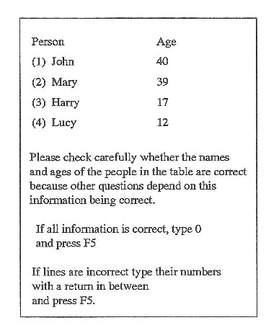Summary and Correction Screens
 A SC screen as created with Interv for household information
A SC screen as created with Interv for household information
Not only in questions about opinions respondents make errors, also in questions about factual information errors occur. In such cases the consequences can be much more problematic, especially when the answers are used for branching to different questions. For example if for a person is indicated that he is working while this was a mistake, the next questions about his work can not be answered by the respondent. Interviewers can be trained how to solve such problems. If the form of data collection is computer assised data collection (CASI) or a web survey, the respondent has to solve the problem by him/herself. However many respondents do not have sufficient skills or motivation to do so. In that case it often will lead to incomplete responses because people stop answering at that point.
In order to prevent these problems in the Telepanel De PIjper and Saris (1986) have developed a procedure which they called the "Summary and Correction screen" or SC screen. In the SC screen answers to previous questions are presented in a clear way so that a respondent immediately can see if and where an error was made. These screens were used if the information was very relevant or if the information was used for routing later in the questionnaire.
A typical situation where such a procedure turned out to be very useful is to summarize the information that is collected in a household box that is the information about members of the household. In that case the information about the different members is later used for further questions. This can lead to confusion if some of the information is incorrect. A typical example of such a SC screen with respect to household information is presented at the side.
It will be clear that it is good to check such information because if Lucy for example would have made a mistake with respect to her age, say it should have been 22 in stead of 12, very different questions would have been asked later on. It is also nice that the names are checked because it is not nice if one asks each time a question about Barry while it has to be Harry. People see these errors immediately and can make the necessary corrections. Nobody complains about such a procedure. Such procedures can also be used to reduce the work for the respondents in panel research as we will show next.
In order to prevent these problems in the Telepanel De PIjper and Saris (1986) have developed a procedure which they called the "Summary and Correction screen" or SC screen. In the SC screen answers to previous questions are presented in a clear way so that a respondent immediately can see if and where an error was made. These screens were used if the information was very relevant or if the information was used for routing later in the questionnaire.
A typical situation where such a procedure turned out to be very useful is to summarize the information that is collected in a household box that is the information about members of the household. In that case the information about the different members is later used for further questions. This can lead to confusion if some of the information is incorrect. A typical example of such a SC screen with respect to household information is presented at the side.
It will be clear that it is good to check such information because if Lucy for example would have made a mistake with respect to her age, say it should have been 22 in stead of 12, very different questions would have been asked later on. It is also nice that the names are checked because it is not nice if one asks each time a question about Barry while it has to be Harry. People see these errors immediately and can make the necessary corrections. Nobody complains about such a procedure. Such procedures can also be used to reduce the work for the respondents in panel research as we will show next.
